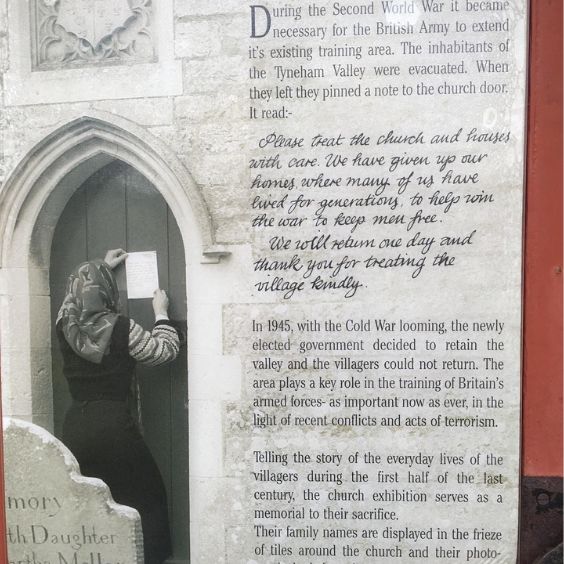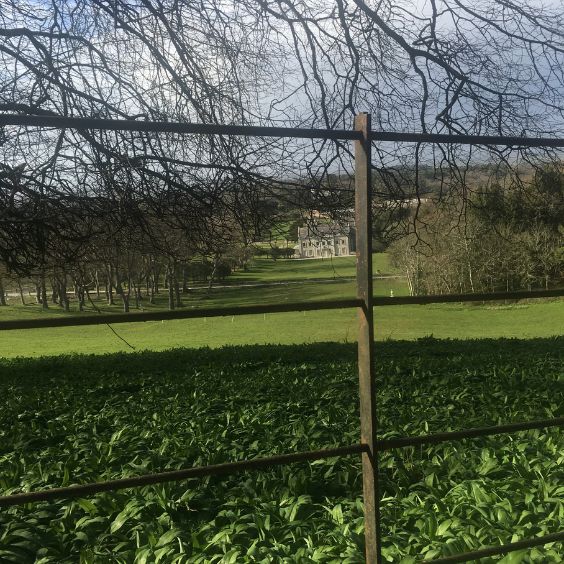The small, deserted village of Tyneham is located 7 miles from our Dorset bed and breakfast in the southwest corner of Purbeck.

The village is a fascinating reminder of lost, rural Dorset life.
With the threat of an invasion of mainland Europe during WW2, the war cabinet decided to evacuate the whole of Tyneham valley so that it could be used as an army training ground for the D-Day landings.
On the 16th November 1943 letters were posted to the 225 inhabitants in 102 properties informing them that they had to leave their homes by the 19th December.
The inhabitants were given a month to evacuate.

A note was pinned to the church which read:
‘Please treat the church and houses with care. We have given up our homes where many of us have lived for generations, to help win the war to keep men free. We shall return one day and thank you for treating the village kindly.’
The deserted village of Tyneham has been part of the Lulworth firing range ever since.
Before the War
Before the war, Tyneham was a secluded agricultural community, owned by the Bond family.
The Bonds owned three Purbeck estates. Those being Tyneham House, Creech Grange and Holme Priory.

Creech Grange, a magnificent house can be seen on the right as you drive up the hill off the A351 from Wareham towards Tyneham village. It was bought by Nathaniel Bond in 1683, an Oxford educated barrister and MP for Corfe Castle in 1689.
The Tyneham Estate was managed by seven generations of the Bond family until the forced evacuations in 1943.
Holme Priory is still home to a branch of the Bond family today.

Picturesque and geographically isolated, tiny cottages were clustered around a village green, St Mary’s Church and a small school.
Visitors today can step inside the school room and the church.
(Saint Mary’s Church in Tyneham can be viewed alongside other local churches within 10 miles of us in our blog ‘5 Local Churches in Dorset’.)

The deserted village of Tyneham sits a short distance inland from a delightful bay called Worbarrow Bay.
The bay once provided a sheltered haven for fishermen and smugglers.
The smuggling trade flourished in the 18th and early 19th century. Worbarrow Bay was a popular drop off point for smugglers.
Smuggling became so widespread that the Coastguard Service was founded in 1822 and cottages were built for the coastguard men and their families on the edge of the bay.
At the beginning of the 20th century, smuggling had ceased to be such a major problem, which led to the station closure in 1912. The buildings were soon demolished on the instructions of William Bond who didn’t want them converted for other use. The removal of the Coastguards was keenly felt by Tyneham’s school which suddenly lost nearly half its pupils.
According to Helen Taylor, a seamstress at Tyneham House who lived in the village up until the evacuation, the fishermen and the Coastguards did not always get on well. The fishermen found the wood from shipwrecks very useful, but salvage was the responsibility of the Coastguard Service.
The Miller family, who had been fishing there well over 200 hundred years, caught a variety of fish but it was lobsters that were the main source of income; carts daily took lobsters and a few crabs to market in Wareham.
The ruins of Sea Cottage, home to Henry Miller’s son Jack and his wife Alice White Rose up until the evacuation, both aged 77, can be found at the left end of the bay.
The Evacuation
During the evacuation, the Bond family endeavoured to look after ‘their’ villagers, many of whom were dependent on a living from Tyneham House.
It was a particularly harsh winter, and the move was heart-breaking for many, especially those that were old and frail.
As Helen Taylor wrote: ‘People’s lives, in fact a whole way of life, disintegrated in a short space of time.’
Farmers had to sell their livestock and farm implements, at low prices as buyers were aware of their need to sell, and the Bonds hurriedly stored precious belongings in the cellar of the great Tyneham House.
The villagers were largely tenants of the Bonds and initially the only compensation they received was quite literally the value of the vegetables in their gardens. Vacant properties in the surrounding area were taken over to house the evacuees.
Despite apparent promises to the contrary, the inhabitants were reassured that their homes would be there for them when the war was over. However, the army admitted that new, unforeseen circumstances dictated that the army should now retain the land.
With the onset of the Cold War, it meant that Britain’s armed forces would continue to train for future conflicts. Bigger tanks demanded more space and the fact that the ranges were next to the sea was convenient.
A public enquiry took place in March 1948 in Wareham and it was decided that public interests should come first and that the army could compulsorily purchase the land. The government was encouraged to compensate the evacuees generously.
They did this by funding the council to enable them to build homes for the villagers which they could rent at roughly what they were paying previously.
They built a new council estate in Sandford near Wareham, renaming the road ‘Tyneham Close’. Many were now comfortably placed and enjoying electricity and indoor sanitation.
Working with local councils, the army began to develop public access to Tyneham village, making the buildings safe and providing information for visitors. Today a team of wardens maintain access to the village. Consequently, since 1979 Tyneham has been open to the public most weekends and during school holidays.

Opening Times
Tyneham is open most weekends and during school holidays.
For a recorded message of opening times, call 01929 404714. Further information can be found at http://www.tynehamopc.org.uk
How to get there
On the A351 from Wareham to Corfe Castle, take the small road signed Kimmeridge. At the top of Ridgeway Hill turn right through gateway (shut when ranges are closed-red flag). The road to Tyneham is a little way along on the left.
Parking
There is a large car park, entrance to Tyneham is free but a donation towards the upkeep of the village is requested. There is no café, shop or drinking water available. There are toilets near the farm.

Walking to Worbarrow Bay
A short one-mile easy walk along a gravel path to Worbarrow Bay. There is a slope down to get to the beach, which is pebbly in part, so walking shoes are advised.
Part of the fascination of the deserted village of Tyneham is that, although in ruins, is as it was left in 1943 and has prompted us to imagine what life was like in an isolated rural community in the first half of the 20th Century.
It really is worth a visit!
If you enjoyed reading this blog and would like to learn about updates, events in the area or last-minute availability at our Dorset B&B, Spurwing Guest House, you can subscribe to our mailing list.
Information to write this blog was gained from ‘The Tyneham Story’ by Robert Westwood and Lynda Price.









